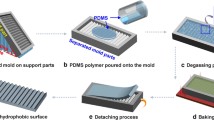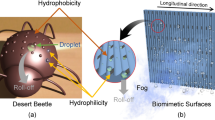Abstract
Polymer surfaces with wettability gradient were fabricated using three-dimensional (3D) printing technology to control the velocity of droplets on the surfaces. A microscale pattern of a semicircular casting mold was created layer-by-layer using a 3D printer based on fused deposition modeling. A surface with a wettability gradient was fabricated by replicating the semicircular mold with a continuously varying surface slope. Water contact angle measurements and droplet test results demonstrated the characterization of the wettability gradient. Droplets were released on a gradient surface inclined at 80°, and their movements were controlled; the locations of the droplets after collision on the ground were tracked. The distance of the main drop and splash drop was found to be reduced by 96.7% (from 6.1 to 0.2 cm) and 87.8% (from 18.8 to 2.3 cm), respectively, compared to that on a general superhydrophobic surface. This study demonstrates a simple, rapid, and inexpensive microfabrication method for functional polymer surfaces to control droplet movement using 3D printing technology.












Similar content being viewed by others
References
Ensikat, H. J., Ditsche-Kuru, P., Neinhuis, C., & Barthlott, W. (2011). Superhydrophobicity in perfection: The outstanding properties of the lotus leaf. Beilstein Journal of Nanotechnology, 2, 152–161.
Latthe, S. S., Terashima, C., Nakata, K., & Fujishima, A. (2014). Superhydrophobic surfaces developed by mimicking hierarchical surface morphology of lotus leaf. Molecules, 19, 4256–4283.
Bhushan, B., & Her, E. K. (2010). Fabrication of superhydrophobic surfaces with high and low adhesion inspired from rose petal. Langmuir, 26, 8207–8217.
Feng, L., Zhang, Y., Xi, J., Zhu, Y., Wang, N., Xia, F., & Jiang, L. (2008). Petal effect: A superhydrophobic state with high adhesive force. Langmuir, 24, 4114–4119.
Oeffner, J., & Lauder, G. V. (2012). The hydrodynamic function of shark skin and two biomimetic applications. The Journal of Experimental Biology, 215, 785–795.
Wen, L., Weaver, J. C., & Lauder, G. V. (2014). Biomimetic shark skin: Design, fabrication and hydrodynamic function. The Journal of Experimental Biology, 217, 1656–1666.
Gu, Z. Z., Uetsuka, H., Takahashi, K., Nakajima, R., Onishi, H., Fujishima, A., & Sato, O. (2003). Structural color and the lotus effect. Angewandte Chemie International Edition, 42, 894–897.
Seo, K., Wober, M., Steinvurzel, P., Schonbrun, E., Dan, Y., Ellenbogen, T., & Crozier, K. B. (2011). Multicolored vertical silicon nanowires. Nano Letters, 11, 1851–1856.
Ma, M., & Hill, R. M. (2006). Superhydrophobic surfaces. Current Opinion in Colloid & Interface Science, 11, 193–202.
Onda, T., Shibuichi, S., Satoh, N., & Tsujii, K. (1996). Super-water-repellent fractal surfaces. Langmuir, 12, 2125.
Tian, P., & Guo, Z. (2017). Bioinspired silica-based superhydrophobic materials. Applied Surface Science, 426, 1–18.
Singh, A. K., & Singh, J. K. (2019). An efficient use of waste PE for hydrophobic surface coating and its application on cotton fibers for oil-water separator. Progress in Organic Coatings, 131, 301–310.
Kooij, E. S., Jansen, H. P., Bliznyuk, O., Poelsema, B., & Zandvliet, H. J. W. (2012). Directional wetting on chemically patterned substrates. Colloids and Surfaces A: Physicochemical and engineering Aspects, 413, 328–333.
Chowdhury, I. U., Sinha Mahapatra, P., & Sen, A. K. (2019). Self-driven droplet transport: Effect of wettability gradient and confinement. Physics of Fluids, 31, 1–12.
Nakashima, Y., Nakanishi, Y., & Yasuda, T. (2015). Automatic droplet transportation on a plastic microfluidic device having wettability gradient surface. The Review of Scientific Instruments, 86, 1–6.
Lee, J. H., Khang, G., Lee, J. W., & Lee, H. B. (1998). Interaction of different types of cells on polymer surfaces with wettability gradient. Journal of Colloid and Interface Science, 205, 323–330.
Kim, M. S., Khang, G., & Lee, H. B. (2008). Gradient polymer surfaces for biomedical applications. Progress in Polymer Science, 33, 138–164.
Sun, C., Zhao, X. W., Han, Y. H., & Gu, Z. Z. (2008). Control of water droplet motion by alteration of roughness gradient on silicon wafer by laser surface treatment. Thin Solid Films, 516, 4059–4063.
Wang, X., Xu, B., Chen, Y., Ma, C., & Huang, Y. (2019). Fabrication of micro/nano-hierarchical structures for droplet manipulation via velocity-controlled picosecond laser surface texturing. Optics and Lasers in Engineering, 122, 319–327.
Qi, L., Niu, Y., Ruck, C., & Zhao, Y. (2019). Mechanical-activated digital microfluidics with gradient surface wettability. Lab on a Chip, 19, 223–232.
Morgenthaler, S., Lee, S., Zürcher, S., & Spencer, N. D. (2003). A simple, reproducible approach to the preparation of surface-chemical gradients. Langmuir, 19, 10459–10462.
Liao, Q., Wang, H., Zhu, X., & Li, M. (2006). Liquid droplet movement on horizontal surface with gradient surface energy. Science in China Series E: Technological Sciences, 49, 733–741.
Zhang, G., Zhang, X., Li, M., & Su, Z. (2014). A surface with superoleophilic-to-superoleophobic wettability gradient. ACS Applied Materials & Interfaces, 6, 1729–1733.
Zhang, J., & Han, Y. (2008). A topography/chemical composition gradient polystyrene surface: Toward the investigation of the relationship between surface wettability and surface structure and chemical composition. Langmuir, 24, 796–801.
Zhao, N., Li, M., Gong, H., & Bai, H. (2020). Controlling ice formation on gradient wettability surface for high-performance bioinspired materials. Science Advances, 6, 1–10.
Liu, H., Xu, J., Li, Y., Li, B., Jun, M., & Zhang, X. (2006). Fabrication and characterization of an organic-inorganic gradient surface made by polymethylsilsesquioxane (PMSQ). Macromolecular Rapid Communications, 27, 1603–1607.
Banuprasad, T. N., Vinay, T. V., Subash, C. K., Varghese, S., George, S. D., & Varanakkottu, S. N. (2017). Fast transport of water droplets over a thermo-switchable surface using rewritable wettability gradient. ACS Applied Materials & Interfaces, 9, 28046–28054.
Yu, X., Wang, Z., Jiang, Y., & Zhang, X. (2006). Surface gradient material: From superhydrophobicity to superhydrophilicity. Langmuir, 22, 4483–4486.
Sehayek, T., Vaskevich, A., & Rubinstein, I. (2003). Preparation of graded materials by laterally controlled template synthesis. Journal of the American Chemical Society, 125, 4718–4719.
Liu, C., Sun, J., Li, J., Xiang, C., Che, L., Wang, Z., & Zhou, X. (2017). Long-range spontaneous droplet self-propulsion on wettability gradient surfaces. Scientific Reports, 7, 1–8.
Huang, D. J., & Leu, T. S. (2013). Fabrication of high wettability gradient on copper substrate. Applied Surface Science, 280, 25–32.
Tokunaga, A., & Tsuruta, T. (2020). Enhancement of condensation heat transfer on a microstructured surface with wettability gradient. International Journal of Heat and Mass Transfer, 156, 119839.
Pitt, W. G. (1989). Fabrication of a continuous wettability gradient by radio frequency plasma discharge. Journal of Colloid and Interface Science, 133, 223–227.
Ito, Y., Heydari, M., Hashimoto, A., Konno, T., Hirasawa, A., Hori, S., & Nakajima, A. (2007). The movement of a water droplet on a gradient surface prepared by photodegradation. Langmuir, 23, 1845–1850.
Daniel, S., & Chaudhury, M. K. (2002). Rectified motion of liquid drops on gradient surfaces induced by vibration. Langmuir, 18, 3404–3407.
Furet, B., Poullain, P., & Garnier, S. (2019). 3D printing for construction based on a complex wall of polymer-foam and concrete. Additive Manufacturing, 28, 58–64.
Vyatskikh, A., Delalande, S., Kudo, A., Zhang, X., Portela, C. M., & Greer, J. R. (2018). Additive manufacturing of 3D nano-architected metals. Nature Communiations, 9, 1–8.
Buj-Corral, I., Bagheri, A., Domínguez-Fernández, A., & Casado-López, R. (2019). Influence of infill and nozzle diameter on porosity of FDM printed parts with rectilinear grid pattern. Procedia Manufacturing, 41, 288–295.
Sukindar, N. A., Ariffin, M. K. A., Hang Tuah Baharudin, B. T., Jaafar, C. N. A., & Ismail, M. I. S. (2016). Analyzing the effect of nozzle diameter in fused deposition modeling for extruding polylactic acid using open source 3D printing. Journal of Teknol, 78, 7–15.
Shin, S., & So, H. (2020). Effect of 3D printing raster angle on reversible thermo-responsive composites using PLA/Paper bilayer. Smart Materials and Structures, 29, 105016.
Sung, J., & So, H. (2021). 3D printing-assisted fabrication of microgrid patterns for flexible antiadhesive polymer surfaces. Surfaces and Interfaces, 23, 100935.
Ding, S., Zou, B., Wang, P., & Ding, H. (2019). Effects of nozzle temperature and building orientation on mechanical properties and microstructure of PEEK and PEI printed by 3D-FDM. Polymer Testing, 78, 105948.
Alsoufi, M. S., Alhazmi, M. W., Suker, D. K., Alghamdi, T. A., Sabbagh, R. A., Felemban, M. A., & Bazuhair, F. K. (2019). Experimental characterization of the influence of nozzle temperature in FDM 3D printed pure PLA and advanced PLA+. American Journal of Mechanical Engineering, 7, 45–60.
Akhoundi, B., Nabipour, M., Hajami, F., & Shakoori, D. (2020). An experimental study of nozzle temperature and heat treatment (Annealing) effects on mechanical properties of high-temperature polylactic acid in fused deposition modeling. Polymer Engineering and Science, 60, 979–987.
Kang, B., Hyeon, J., & So, H. (2020). Facile microfabrication of 3-dimensional (3D) hydrophobic polymer surfaces using 3D printing technology. Applied Surface Science, 499, 143733.
Kang, B., Sung, J., & So, H. (2021). Realization of superhydrophobic surfaces based on three-dimensional printing technology. International Journal of Precision Engineering and Manufacturing-Green Technology, 8(1), 47–55.
Xu, Z., & Lü, F. (2013). A static contact angle algorithm and its application to hydrophobicity measurement in silicone rubber corona aging test. IEEE Transactions on Dielectrics and Electrical Insulation, 20, 1820–1831.
Ali, M., & Hackam, R. (2008). Effects of saline water and temperature on surface properties of HTV silicone rubber. IEEE Transactions on Dielectrics and Electrical Insulation, 15, 1368–1378.
Ruben, B., Elisa, M., Leandro, L., Victor, M., Gloria, G., Marina, S., & Nadhira, L. (2017). Oxygen plasma treatments of polydimethylsiloxane surfaces: effect of the atomic oxygen on capillary flow in the microchannels. Micro & Nano Letters, 12, 754–757.
Wenzel, R. N. (1936). Resistance of solid surfaces to wetting by water. Industrial and Engineering Chemistry, 28, 988–994.
Cassie, A. B. D., & Baxter, S. (1944). Wettability of porous surfaces. Transactions of the Faraday Society, 40, 546–551.
Faria-Briceno, J. J., Neumann, A., Schunk, P. R., & Brueck, S. R. J. (2019). Measuring liquid drop properties on nanoscale 1D patterned photoresist structures. Scientific Reports, 9, 1–9.
Cheng, C. T., To, S., & Zhang, G. (2020). Characterization of intermediate wetting states on micro-grooves by water droplet contact line. Journal of Industrial and Engineering Chemistry, 91, 69–78.
Xu, J., Hou, Y., Lian, Z., Yu, Z., Wang, Z., & Yu, H. (2020). Bio-inspired design of bi/tridirectionally anisotropic sliding superhydrophobic titanium alloy surfaces. Nanomaterials, 10, 1–17.
Zheng, Y., Gao, X., & Jiang, L. (2007). Directional adhesion of superhydrophobic butterfly wings. Soft Matter, 3, 178–182.
Acknowledgements
This work was supported by a National Research Foundation of Korea (NRF) grant funded by the Korean government (MSIT) (No. NRF-2020R1A4A1019074).
Author information
Authors and Affiliations
Corresponding author
Ethics declarations
Conflict of interest
There are no conflicts to declare.
Additional information
Publisher’s Note
Springer Nature remains neutral with regard to jurisdictional claims in published maps and institutional affiliations.
Supplementary Information
Below is the link to the electronic supplementary material.
Supplementary file1 (MOV 52694 kb)
Rights and permissions
About this article
Cite this article
Sung, J., Lee, H.M., Yoon, G.H. et al. One-Step Fabrication of Superhydrophobic Surfaces with Wettability Gradient Using Three-Dimensional Printing. Int. J. of Precis. Eng. and Manuf.-Green Tech. 10, 85–96 (2023). https://doi.org/10.1007/s40684-022-00418-y
Received:
Revised:
Accepted:
Published:
Issue Date:
DOI: https://doi.org/10.1007/s40684-022-00418-y




